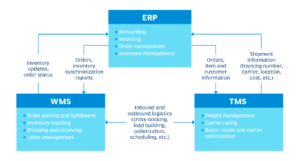In the intricate world of supply chain management, optimizing distribution networks is a constant challenge for businesses aiming to enhance efficiency and reduce costs. Two prominent strategies, TMS Network Distribution and Hub & Spoke, stand out as effective approaches. In this blog, we’ll delve shortly into these strategies, comparing their benefits, use cases, and implications for businesses.
TMS Network Distribution:
TMS (Transportation Management System) Network Distribution involves the use of advanced technology and a comprehensive transportation management system to create a network of interconnected routes for efficient distribution. The focus is on real-time visibility, data-driven decision-making, and dynamic route planning. Here’s what makes TMS Network Distribution a valuable approach:
-

Main functions of a transport management system (TMS) Real-Time Insights: With TMS, businesses gain real-time visibility into their transportation operations. This enables them to monitor shipments, track delivery status, and promptly address any issues that arise.
- Dynamic Routing: TMS allows for dynamic route optimization based on various factors such as traffic conditions, delivery priorities, and fuel efficiency. This minimizes empty miles and ensures cost-effective routes.
- Scalability: TMS Network Distribution is highly scalable, making it suitable for businesses with fluctuating transportation needs. It adapts to changes in demand, ensuring efficient distribution even during peak seasons.
Hub & Spoke:
The Hub & Spoke model revolves around a central hub (distribution center) connected to multiple spokes (smaller warehouses or retail outlets). This approach aims to consolidate shipments, streamline distribution, and reduce transportation costs. Here’s why Hub & Spoke is a compelling strategy:
- Consolidation: The central hub serves as a consolidation point for shipments from various sources. This reduces the number of direct routes, lowers transportation expenses, and minimizes redundant efforts.
- Efficient Allocation: By strategically placing spokes in key locations, businesses can optimize the allocation of goods, ensuring they reach customers swiftly while minimizing the distance traveled.
- Flexibility: The Hub & Spoke model provides flexibility in managing inventory. It allows for better inventory control, making it easier to manage stock levels and respond to changing market demands.

Choosing the Right Strategy:
Selecting the appropriate strategy depends on various factors, including the size of your business, the nature of your products, geographical reach, and customer expectations. Both TMS Network Distribution and Hub & Spoke offer distinct advantages, but the ideal choice depends on the specific needs and goals of your supply chain.
Ultimately, efficient distribution is the key to success in today’s competitive market. Whether you opt for the advanced technology-driven TMS Network Distribution or the strategic consolidation approach of Hub & Spoke, the goal remains the same: to optimize your supply chain, deliver value to customers, and drive business growth.

Navitrans Transport Management System (ERP, WMS & TMS)
With Navitrans Logistics Software, businesses can effectively manage their transport- and warehouse management operations, including order processing, graphical planning board, route optimization, portals and control tower. The software provides real-time supply chain visibility into transport and warehouse operations and helps automate various transportation and warehousing tasks, leading to improved productivity and reduced errors. Navitrans is based on Microsoft Dynamics 365 Business Central.
Author is Harry Luijk – Logistics & Supply Chain Professional – CCO at Navitrans a Valsoft Aspire Software Company | Partner at Merlyn Consult.


